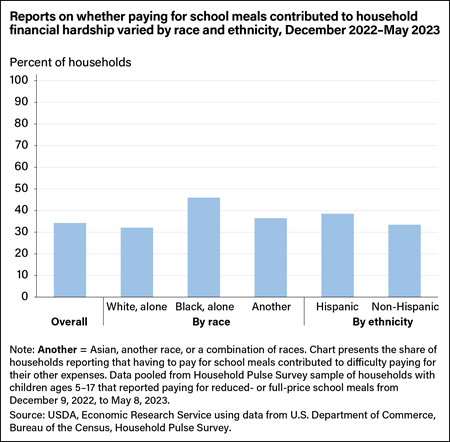One-Third of Households With Children Paying for School Meals Reported That Doing So Contributed to Financial Hardship

Children typically receive meals through USDA’s National School Lunch Program and School Breakfast Program for free, at a reduced-price (no more than $0.40 cents for a school lunch and $0.30 cents for a school breakfast), or at full price (generally no more than $3) depending on their household’s income. This changed in response to the Coronavirus (COVID-19) pandemic. To facilitate the continued provision of school meals during pandemic-related disruptions to school operations, USDA issued a waiver allowing schools to serve free meals to all children nationwide, regardless of income. This waiver expired in June 2022, and, absent other State or local policies, schools went back to charging some children for school meals in the 2022–2023 school year.
The expiration of USDA’s waiver raised concerns among some advocates and policymakers that charging for school meals would increase financial hardship—defined as difficulty paying for expenses—among families that continued to struggle with the pandemic and its economic fallout, such as rising inflation. A recent USDA, Economic Research Service (ERS) study used new data from the Household Pulse Survey (HPS) to document the share of households reporting that paying for school meals contributed to their financial hardship among households with school-aged children who paid for school meals. The U.S. Department of Commerce, Bureau of the Census, together with ERS and other Federal agencies, developed the HPS to produce timely information on the economic and social effects of the pandemic on U.S. households. Beginning with the survey fielded from December 9 to 19, 2022, the HPS asked respondents from households with school-aged children whether they received free, reduced-price, or full-price school meals. Those who responded that the children in their household received reduced- or full-price meals were also asked whether having to pay for the food their children ate at school made it difficult to pay other household expenses.
The ERS study found that about 32 percent of all households with school-aged children who paid for school meals reported that doing so contributed to their financial hardship in the period December 9 to 19, 2022. That share remained about the same through the remainder of the 2022–2023 school year and was 35 percent in the period from April 16 through May 8, 2023. The study also found that the share varied across households by race and ethnicity in the period from December 9 to 19, 2022.
HPS data collected from December 9, 2022, to May 8, 2023, were combined for this article to document these shares for the second half of the 2022–2023 school year. Over that period, 32 percent of White households with school-aged children who paid for school meals reported that doing so contributed to their financial hardship. The share for non-Hispanic households during the same period was about 33 percent. The shares were higher among Black households (46 percent); non-White, non-Black households, which fall in the category of “another” race (36 percent); and Hispanic households (39 percent).
Further research could examine the extent to which the cost of school meals contributes to households’ financial hardship relative to other factors. Additionally, without similar data from pre-pandemic years, it is unknown how the share reporting that paying for school meals contributed to their financial hardship in the 2022–2023 school year compares with a typical school year. However, these descriptive findings provide context to discussions about how the expiration of USDA’s free-meal waiver may have affected households.
Cost of School Meals and Households’ Difficulty Paying for Expenses: Evidence From the Household Pulse Survey, by Saied Toossi, ERS, July 2023
The Food and Nutrition Assistance Landscape: Fiscal Year 2022 Annual Report, by Saied Toossi and Jordan W. Jones, ERS, June 2023
The Food and Nutrition Assistance Landscape: Fiscal Year 2021 Annual Report, by Jordan W. Jones, Saied Toossi, and Leslie Hodges, ERS, June 2022
The Food and Nutrition Assistance Landscape: Fiscal Year 2020 Annual Report, by Saied Toossi, Jordan W. Jones, and Leslie Hodges, ERS, August 2021
COVID-19 Working Paper: Filling the Pandemic Meal Gap: Disruptions to Child Nutrition Programs and Expansion of Free Meal Sites in the Early Months of the Pandemic, by Saied Toossi, ERS, October 2021


